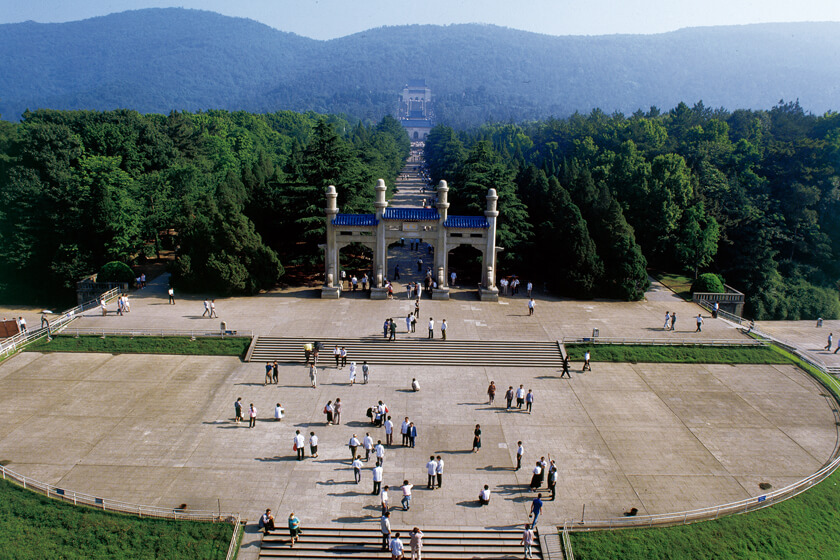Capital to 10 dynasties and regimes over 1,800 years, Nanjing has witnessed some of China’s most important figures and historical events. From sacred tombs and temples to solemn memorial sites, these landmarks reveal the lasting legacy of this fascinating city.

Purple Mountain (Zhongshan Mountain National Park)
Towering in the eastern suburbs of Nanjing, Purple Mountain is one of the most well-known mountains in Southern China. The beautiful mountain got its name from the purple hued clouds that often surround its peak. The national park that encompasses Purple Mountain is home to 15 important historical and cultural relics including Dr. Sun Yat-sen's Mausoleum, and one UNESCO World Heritage Site – the Xiaoling Tomb of Ming Dynasty.
Dr. Sun Yat-sen’s Mausoleum
The mausoleum of Dr. Sun Yat-sen (1866-1925), the father of the Republic of China, is a site of deep historical significance, magnificent architecture and beautiful scenery located at the Zhongshan Scenic Area in Purple Mountain. Covering nearly 20 acres, the lush scenic is a tribute to the noble spirit and heroic efforts of Dr. Sun Yat-sen's devotion to the Chinese people and their fight for independence. Visitors can view the memorial archway, mausoleum gate, tombstone pavilion and memorial hall. The coffin chamber is not accessible to visitors.
Location: Xuanwu
Hours: Tuesday–Sunday, 8:30 a.m.–5 p.m.; Closed Monday
Admission: Mausoleum, including Fraternity Square, the Mausoleum Passage, the Stele Pavilion, the Sacrificial Hall and the Burial Room, free
Xiaoling Tomb of the Ming Dynasty
The mausoleum of the Ming Dynasty’s founding emperor, Zhu Yuanzhang, and his wife Ma, is one of the largest imperial tomb complexes in China. The most iconic part of the 600-year-old UNESCO World Heritage Site is the half-mile long Sacred Path, along which four pairs of stone warriors and 12 pairs of mythical creatures play guard to the deceased emperor. The tomb is set amongst an incredibly scenic environment where seasonal plants form breathtaking backdrops -- plum blossom in spring and gingko and maple trees in autumn.
Location: Wengzhong Road, Xuanwu District
Hours: 6:30 a.m.–5 p.m. daily
Admission: CNY 70 (US $10.60)
Grand Bao’en Temple
The Grand Bao’en Temple, also known as the Porcelain Tower, was a soaring Ming-era pagoda and one of the Seven Medieval Wonders of the World before it was destroyed during the Taiping Rebellion of the 19th century. In recent years, local businessman Wang Jianlin made it his mission to resurrect the temple—granting what is said to be the largest personal donation ever made in China. Now, the nine-story Grand Bao’en Temple has been restored to its full glory, along with an ultramodern museum that recalls the landmark’s history, located on the south bank of the Qinhuai River.
Location: No.1, Yu Hua Road, outside Zhonghua Gate, Qinhuai District
Hours: 9 a.m.–5 p.m. daily
Admission: CNY 120 (US $18)
Nanjing Massacre Memorial Hall
This stark memorial was established to honor the victims of atrocities wrought by the Imperial Japanese Army during the Nanjing Massacre of 1937. The devastating six-week occupation claimed approximately 300,000 lives, and large swaths of the city were destroyed. The Memorial Hall was built in 1985 on a site known as the “pit of ten thousand corpses,” where scores of bodies were buried, at Jiangdongmen in southwest Nanjing. The hall’s collection includes historical documents, art, photos and survivor testimonies, which were inscribed into the UNESCO World Heritage Memory of the World register in 2015.
Location: 418 Shuiximen Street, Jianye
Hours: 8:30 a.m.–4:30 p.m. daily
Admission: Free
Website: www.nj1937.org/en/
Nanjing City Wall
Visit one of the most significant cultural remnants of Ming rule at the Nanjing City Wall. Dating back to the 14th century, the wall was ordered by Ming dynasty founder Emperor Zhu Yuanzhang to shield Nanjing from invaders when it served as the imperial capital from 1398 to 1421. This masterpiece of ancient Chinese architecture—made of more than 300 million bricks and averaging 39 feet high—was one of the longest city walls in the world, and approximately 15.5 of the original 22 miles are still intact. Six sections are open to public.
Location: Lanqi Street, Qinhuai
Hours: Summer, 8 a.m.–6 p.m.; spring, autumn and winter, 8:30 a.m.–5 p.m.
Admission:
- Shence Gate to Taiping Gate, including the City Wall Museum, CNY 30 (US $4.50)
- Taiping Gate to Guanghua East Street, CNY 20 (US $3)
- East Water Pass to West Water Pass, including the barbican of Zhonghua Gate, CNY 50 (US $7.60)
- Qingliang Gate–Guofang Garden, free
- Dinghuai Gate–Yijiang Gate, free
- Zhongfu Road–Central Gate, free
The Presidential Palace
Featuring lush inner gardens and a blend of Chinese and European architecture, this sprawling compound dates back more than 600 years, when it was constructed as the residence of a Ming dynasty official. The palace played a particularly important role during the 20th century; it was here in 1912 that Chinese revolutionary Dr. Sun Yat-sen was declared the first provisional president of the Republic of China. The palace also served as the government headquarters for Sun’s successor, Chiang Kai-shek, from 1946–1949, and visitors can see Chiang’s office, preserved in its original state.
Location: 292 Changjiang Road, Xuanwu
Hours: December–February, 8:00 a.m.–5 p.m. daily; March–October, 7:30 a.m.–6 p.m. daily; November, 7:30 a.m.–5:30 p.m. daily
Admission: CNY 40 (US $6)
Zhonghua Gate
The biggest castle-style gate in China and one of the most complex castles in the world. #GoToNanjing
Nanjing University
One of the oldest and most prestigious educational institutions in China. #GoToNanjing